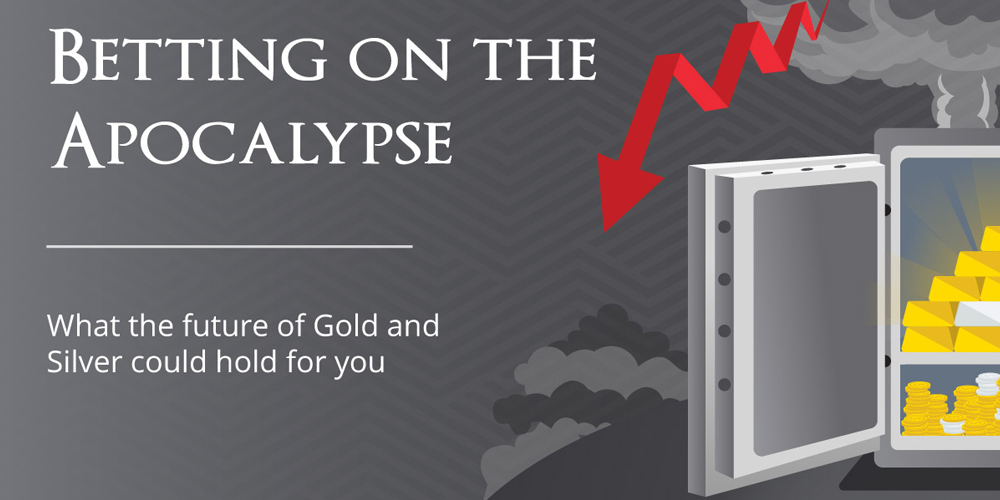
Betting on a Financial Collapse – the Future of Gold
Wealth, war, power, mystery, mythology, currency – these are just some of the words traditionally associated with gold, but what do you think of when you hear the word money?
Do you think of payments, paper, groceries, salary, worries, fears, debt? What is money to you? These are questions we really should be asking ourselves, and how much do you rely on it in your day to day life?
Over the centuries many people have made strong arguments against gold, but these arguments usually come from those who have complete confidence in paper money and no confidence in precious metals. Paper currency has failed before and in all likeliness will again in the future, there’s no escaping it.
Betting on a financial collapse isn’t material for an apocalyptic style movie, it’s just one way of looking at the stark reality of what we’re likely to face in the future. Understanding the facts and history will remove the “horse blinders” for this race and present you with a clear picture of what lies ahead.
Page Contents 內容目錄
Why Is Gold Excellent as a Currency?

There are only eight elements in the periodic table that could be considered for use as a currency and physically crafted into coins. They are what is referred to as noble metals – osmium, iridium, ruthenium, palladium, platinum, rhodium, silver, and gold. They are all rare, but only silver and gold are available in enough quantities to comprise a practical money supply. The rest are too limited or have melting points too high to make it commercially viable.
This leaves just two elements – silver and gold. They are both scarce but not so much that it’s impossible to find enough for world supply. They have relatively low melting points which make it easy enough to turn them into coins, bars or jewelry. However, silver discolors or stains when it reacts with minuscule amounts of sulfur in the air. That’s why gold is the leading contender as a currency and your safest bet in the event of a financial collapse.
Let’s Debunk Some of the Common Myths Associated with Gold
-
“There isn’t enough gold in the world to support finance and commerce”
This is probably the best-known fallacy associated with gold. The world has approximately one hundred and seventy thousand (170k) metric tons in total, and the amount of gold in the world is always fixed at a level, subject to an increase through mining.
What critics are really saying when they say “there isn’t enough gold” is that there isn’t enough gold at current prices. There is always enough to use for a gold standard, as long as a stable, non-deflationary price is established. England successfully used gold as a standard from 1815 to 1914 with around 20 percent gold backing for money. Same goes for the Federal Reserve in the U.S. from 1913 to 1965 with around 40 percent gold backing for the money supply.
The confrontation doesn’t lie against gold as a standard but rather in the real value of paper money to physical gold. The actual conflict will come when confidence in paper money erodes, and a gold standard gains favor as a way to restore our economic system.
-
“Gold is Not an Investment”
Warren Buffett openly criticizes gold by stating that it offers no return and therefore no chance of compounding wealth.
He’s 100 percent right.
Gold has no yield, and it’s not supposed to either because it has NO risk. If you buy an ounce of gold today, put it in a safe and take it out twenty years from now, it will still only be one ounce of gold. But, the dollar price of gold could change drastically in that time, which makes it a dollar issue and not a gold issue.
Simply put, to make money you need to take risks. Gold isn’t a risk! Gold has no issuer risk because nobody issues it. Gold just stays gold.
-
“Gold was the cause of the Great Depression”
The Great Depression was a direct result of incompetent monetary and fiscal policies from the U.S. Federal Reserve from 1927 to 1931. Research shows that at no point in time during the Great Depression was the supply of money strained by the gold supply. There are multiple factors to blame for the Great Depression:
-
- Reduction in purchasing across the board due to uncertainties about tax and labor policies
-
- America’s economic policy with Europe
-
- Drought conditions in the US coupled with the outdated farming implementation
-
- The Stock Market crash of 1929 (often thought to be the sole cause of the depression)
- The United Kingdom’s decision to return gold in 1925 at £4.25, the same price gold was pre-World War 1
Gold wasn’t to blame for the Great Depression, a politically calculated gold price was. When gold is undervalued, central bank money is remodeled, and the result is inflation. For a gold standard to work, the price of gold can’t be undervalued, not back then and not today.
All good and well, but why go with gold for your insurance?
Gold is an element; it’s simple, atomic number 79 there’s nothing to it. It’s robust in the face of an international financial collapse, and owning gold is insurance against unstable financial climates and current economic systems. It is the one asset that any investor should own in a complex world like ours because it is so simple.
Gold Isn’t Digital
When you receive your salary, it is likely deposited into your bank account digitally. When you purchase airline tickets or pay the rent, you probably use your credit card or online banking. The amount of actual cash you use is small compared to what you spend monthly. Treasury market bonds today are entirely digital. You can’t go to a bank and withdraw thousands of dollars without being subject to government scrutiny or being suspected of working some or other nefarious deal.
Credit cards are vulnerable up to the point where you now have special wallets to block out magnetic copying machines to prevent credit card theft. Digital wealth is vulnerable to hackers, system failures, exchange and infrastructure collapse, online theft and phishing scams. What good is a huge portfolio if it can be wiped out due to a security breach, in one foul swoop.
A recent example of the system’s vulnerability can be seen from examples like Cyprus in 2013 and Greece in 2015 when the banks reprogrammed the ATM’s to allow a maximum of a few hundred dollars per person per day. In theory, you could have millions in the bank, but if you can’t get to it because the bank prevents you there’s very little you can do.
Without gold, you don’t have a choice but to go along with digitized wealth today, and you’re completely vulnerable in the event of a bank freeze.
Where Does Gold Fit In?
August 15, 1971, President Richard Nixon closed the gold window, effectively removing America from the gold standard. Since then two generations have been educated to believe that gold has no role in the international monetary system, by universities and policymakers.
But, gold never left!
Global financial players, elite and wealthy stopped talking about gold and publicly ignored it, but they never let go. Why keep hoarding and growing a gold stash if it’s worthless? The IMF and Germany hold three thousand tons of gold respectively, while the United States retains more than eight thousand tons. China is stealthily (not so secretly) purchasing thousands of tons of gold. If you’ve been to any gold producing country recently, you would have noticed the Chinese mines scattered everywhere. Major road construction deals are used as barter deals for mining concessions with African governments. Russia is also procuring for more than one hundred tons a year. Which begs the question – why is there such a hustle to obtain gold if it’s perceived as worthless?
Gold has almost no industrial value. Sure, it’s an excellent conductor, but copper is much cheaper, malleable and readily available. Gold has some uses in coatings for electronics, but it’s limited, and if it suddenly became unavailable the industrial sector wouldn’t grind to a halt. Gold is traded as a commodity, but it isn’t really; it doesn’t trade on the same principle of supply and demand as other commodities.
Gold is resilient and has shown resilience through some seriously unfavorable times. True, some investors are frustrated that gold hasn’t fared better, but then again many are happy that gold isn’t trading lower considering what happened to oil, copper and a range of other commodity prices.
Gold has maintained strength in past monetary collapses, and there’s no indication that it won’t do so again in the future.
What Happens If the Monetary System Collapses?
The warning signs are there, both citizens and investors understand (or sense) there is a dormant instability in our global monetary system. You hear it in conversations all around the world – from the slums of West Africa to the bars in South Kensington in West London. The conversation in Africa is directly related to the rising prices of rice and cooking oil due to a deep mistrust in local currency that jumps up and down depending on what the US dollar does. The conversations in bars in London might be on a higher nouveau dealing with portfolio’s but it comes down to the same thing, the people are losing faith in paper money.
All the indicators point towards a global financial collapse due to wishful financial thinking, our historical inability to analyze risks correctly, denial and pure bad science from economists.
Arguments Against an Economic Collapse
Some may argue that everything written so far is based on assumptions or “ifs and buts,” and in a way they are right. But isn’t that exactly what predictions are, somewhat calculated assumptions? In a recent article in the Balance “Top 10 Reasons Why the U.S. Economy Won’t Collapse,” they make their case against an economic collapse with what they refer to as facts. Some of the points used to argue in favor of a non-collapse in the US are:
“The U.S. debt is $19 trillion. That’s more than the economy produces in a year. Though the debt-to-GDP ratio is in the danger zone, it’s not enough to cause a collapse. First, the United States prints its money. That means it is in control of its currency. Lenders feel safe that the U.S. government will pay them back.”
“Lenders feel safe the U.S. government will pay them back” what happens when the lenders don’t feel safe anymore?
“China and Japan are the biggest owners of the U.S. debt. But they have no incentive to create a collapse. The United States is its largest market. If it fails, so do their economies. Furthermore, China is not selling all of its dollar holdings. It has remained above $1 trillion since 2013.”
Although we’re inclined to agree with these statements, the point we’re trying to make is that these aren’t facts at all but also assumptions. Nobody wants to see a collapse, but we can’t ignore the past, and we don’t have the luxury to turn a blind eye when it comes to assumptions regarding our economic future.
It’s important to realize that the world won’t cease to exist if there is an economic collapse, people will still eat, trading will still exist, people will still work. This article’s purpose is not to support doomsday theories (this might seem contrary when you look at the title) but to illustrate the point that an economic collapse could very likely happen. And if these assumptions are correct wouldn’t you want to be better prepared?





















